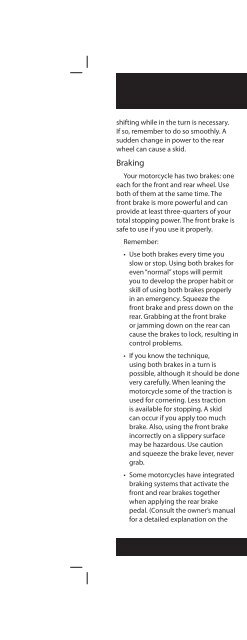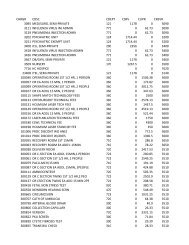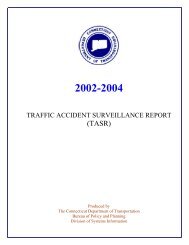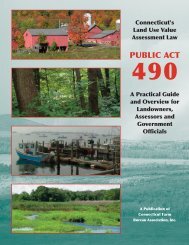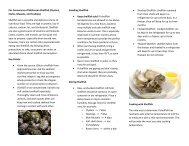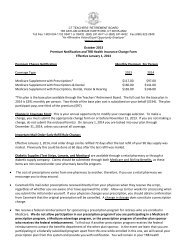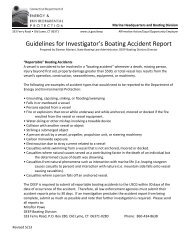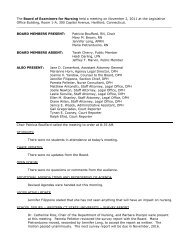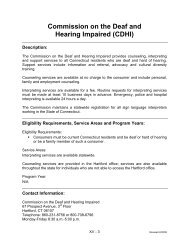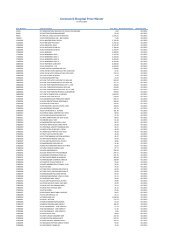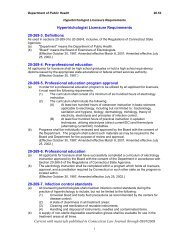The Connecticut Motorcycle Operator's Manual - CT.gov
The Connecticut Motorcycle Operator's Manual - CT.gov
The Connecticut Motorcycle Operator's Manual - CT.gov
You also want an ePaper? Increase the reach of your titles
YUMPU automatically turns print PDFs into web optimized ePapers that Google loves.
shifting while in the turn is necessary.<br />
If so, remember to do so smoothly. A<br />
sudden change in power to the rear<br />
wheel can cause a skid.<br />
Braking<br />
Your motorcycle has two brakes: one<br />
each for the front and rear wheel. Use<br />
both of them at the same time. <strong>The</strong><br />
front brake is more powerful and can<br />
provide at least three-quarters of your<br />
total stopping power. <strong>The</strong> front brake is<br />
safe to use if you use it properly.<br />
Remember:<br />
• Use both brakes every time you<br />
slow or stop. Using both brakes for<br />
even “normal” stops will permit<br />
you to develop the proper habit or<br />
skill of using both brakes properly<br />
in an emergency. Squeeze the<br />
front brake and press down on the<br />
rear. Grabbing at the front brake<br />
or jamming down on the rear can<br />
cause the brakes to lock, resulting in<br />
control problems.<br />
• If you know the technique,<br />
using both brakes in a turn is<br />
possible, although it should be done<br />
very carefully. When leaning the<br />
motorcycle some of the traction is<br />
used for cornering. Less traction<br />
is available for stopping. A skid<br />
can occur if you apply too much<br />
brake. Also, using the front brake<br />
incorrectly on a slippery surface<br />
may be hazardous. Use caution<br />
and squeeze the brake lever, never<br />
grab.<br />
• Some motorcycles have integrated<br />
braking systems that activate the<br />
front and rear brakes together<br />
when applying the rear brake<br />
pedal. (Consult the owner’s manual<br />
for a detailed explanation on the<br />
15<br />
operation and eff ective use of these<br />
systems.)<br />
Turning<br />
Riders often try to take curves or turns<br />
too fast. When they can’t hold the turn,<br />
they end up crossing into another lane<br />
of traffi c or going off the road. Or, they<br />
overreact and brake too hard, causing a<br />
skid and loss of control. Approach turns<br />
and curves with caution.<br />
Use four steps for better control:<br />
• SLOW — Reduce speed before the<br />
turn by closing the throttle and, if<br />
necessary, applying both brakes.<br />
• LOOK — Look through the turn<br />
to where you want to go. Turn<br />
just your head, not your shoulders,<br />
and keep your eyes level with the<br />
horizon.<br />
• PRESS — To turn, the motorcycle<br />
must lean. To lean the motorcycle,<br />
press on the handgrip in<br />
the direction of the turn. Press left<br />
handgrip — lean left — go left.<br />
Press right handgrip — lean right —<br />
go right. <strong>The</strong> higher the speed in a<br />
turn, the greater the lean angle.<br />
• ROLL — Roll on the throttle to<br />
maintain or slightly increase speed.<br />
This helps stabilize the motorcycle.


